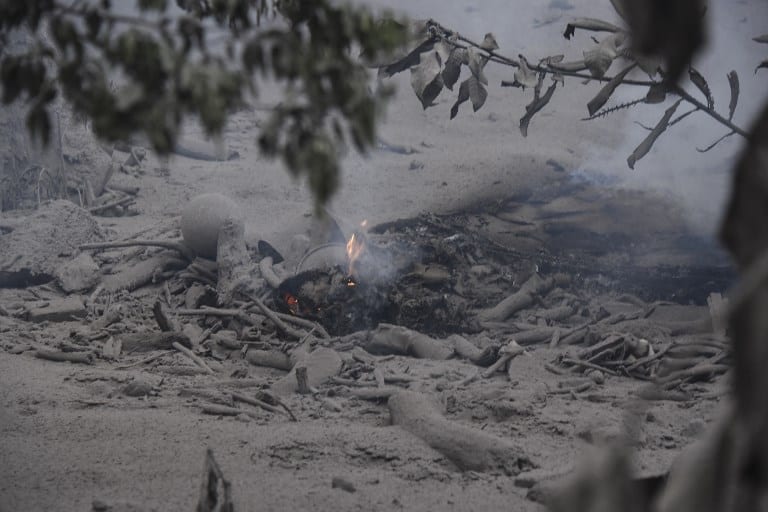Amado Hernández cries because he has lost everything. At the same time, he is thankful for the solidarity that allows him to have food to eat and clothes to wear: he’s one of the survivors of the tragic eruption of Fuego Volcano, and has been living in shelters for a week now.
Amado, 42, tries to digest the tragedy along with his son, Carlos Amadeo, 19. Ever since the eruption on June 3, they have been killing time at the Nuestra Señora de Guadalupe Church in Escuintla, converted into a shelter that’s crammed full of 430 survivors.
“We lost everything,” Hernández recounts, but he “thanks God and the good heart of the people.” Donations have kept up the spirits of 3,858 affected people who cannot return to their homes – either because they’re in danger or because their homes do not exist anymore – and remain in one of the 17 shelters.
The Hernández father and son share with the rest of the people in their shelter a dozen bathrooms and eight showers fashioned from plastic tarps on one side of the church. At a laundry station, they take turns to hand-washing the clothes that they’ve received, given that they all left their belongings behind to save their lives.
Concepción Hernández, Amadeo’s father, died in the early morning hours of Wednesday at 88 years of age in a hospital in Guatemala City due to kidney failure caused by the serious burns he suffered June 3 on 50 percent of his body when he tried to escape from the mantle of burning material that descended from the volcano and buried the town of San Miguel Los Lotes.
Most of the people who spend the day in the shelters are able to do so because they have located their family members. The rest leave the shelter in desperation each morning to visit the devastated area and dig in search of their family members. They are scared that the government will declares the area a cemetery and that the bodies will stay forever buried under the ashes.
The Hernández family says that they at least have the consolation of having been able to bury their family member on Thursday, as well as being able to rest.
“We can’t complain. Here we have everything,” he says before 7 pm, the hour when volunteers from all over Guatemala distribute dinner in the dining room, organized outside and covered with tents to protect the victims from the intense rains that pour down each afternoon in the area.
As far as charity goes
Ashley Ayala is a young woman of 29 years of age who came to the area from the capital to help her fellow citizens because her “body asked for it.” She serves foods to the sheltered, such as the one on Sunday: a plate with rice, chicken, egg and beans.
Individuals and business representatives park now and then in front of the church and distribute their donations, such as the bags full of caramels and toys that are given to each child.
Ayala says that she’ll be in the shelter one more week, but afterwards she asks the “government to provide a place for people to live in.”
This is a worry shared by Julio Roberto Morejón, one of the victims, 23: “I’m fine here now, but where will I go afterwards?”
The Congress of Guatemala gave the green light on Friday to President Jimmy Morales to use the more than $25 million in the national emergency’ fund.
Morejón, however, is left to remember how his aunt Armenia Bucú and his cousin Maribel Bucú disappeared in “cloud of embers that went down through the town” of San Miguel Los Lotes. His family members are part of the tally of casualities of the eruption, with 110 dead and 197 missing at press time.
The baby Calixto Eduardo has come to represent a figure of happiness in the middle of so much death and pain, an example that life continues in a devastated area. His mother, Ingrid Sicán, escaped on foot from El Rodeo during the eruption along with her parents, Vivian, 42, and José, 54.
The young woman, nine months pregnant, reached the shelter safely, and on Tuesday night gave to birth to Calixto there: “Despite of everything we’re going through, (the child) has been a blessing,” she explains, surrounded by neighbors of the community.

